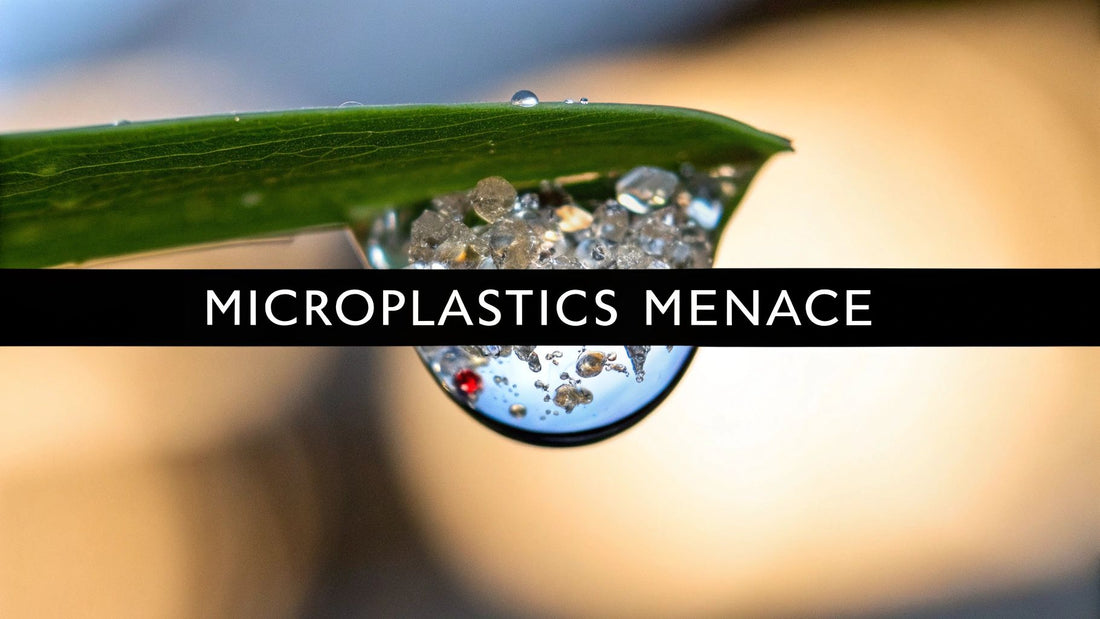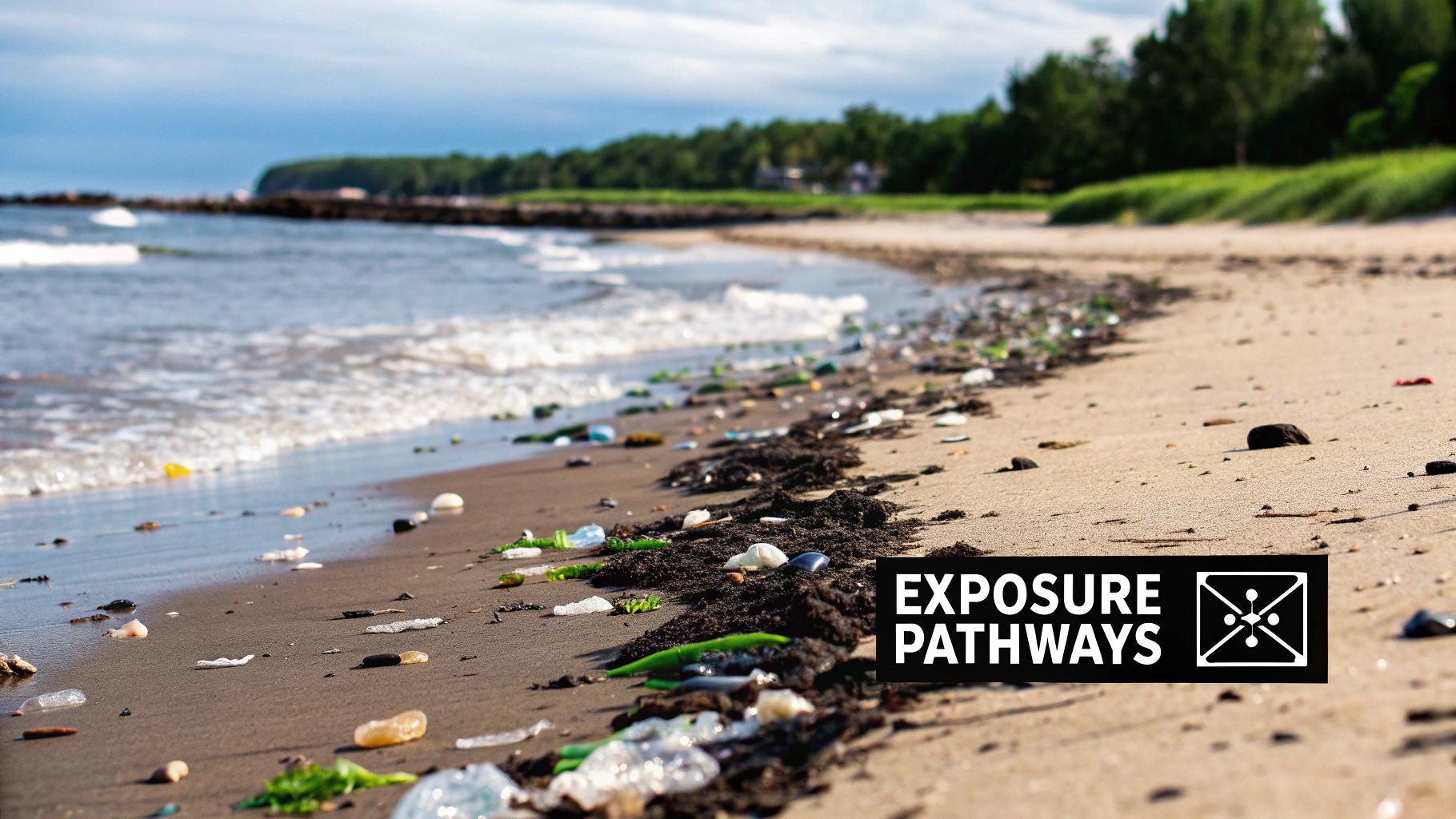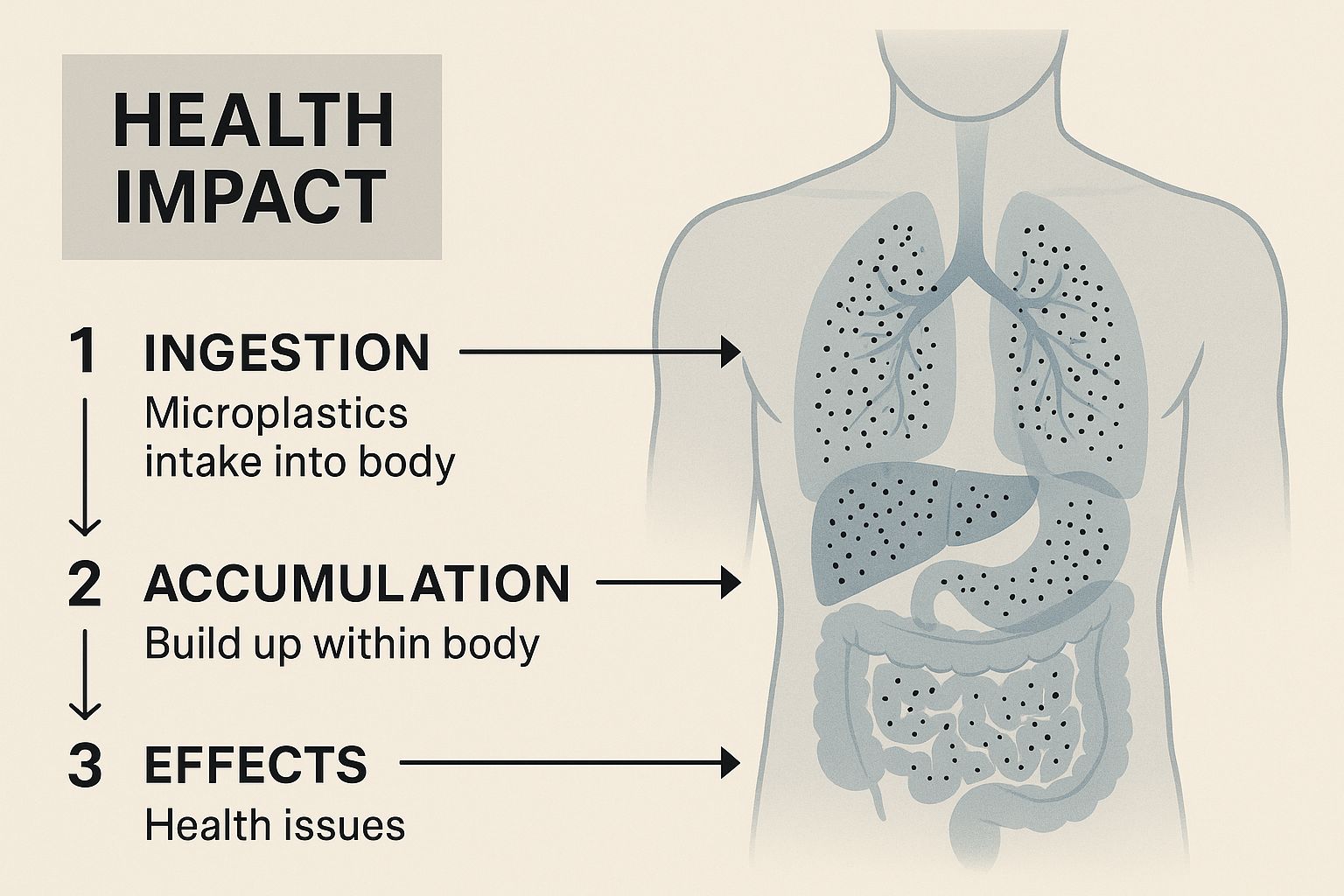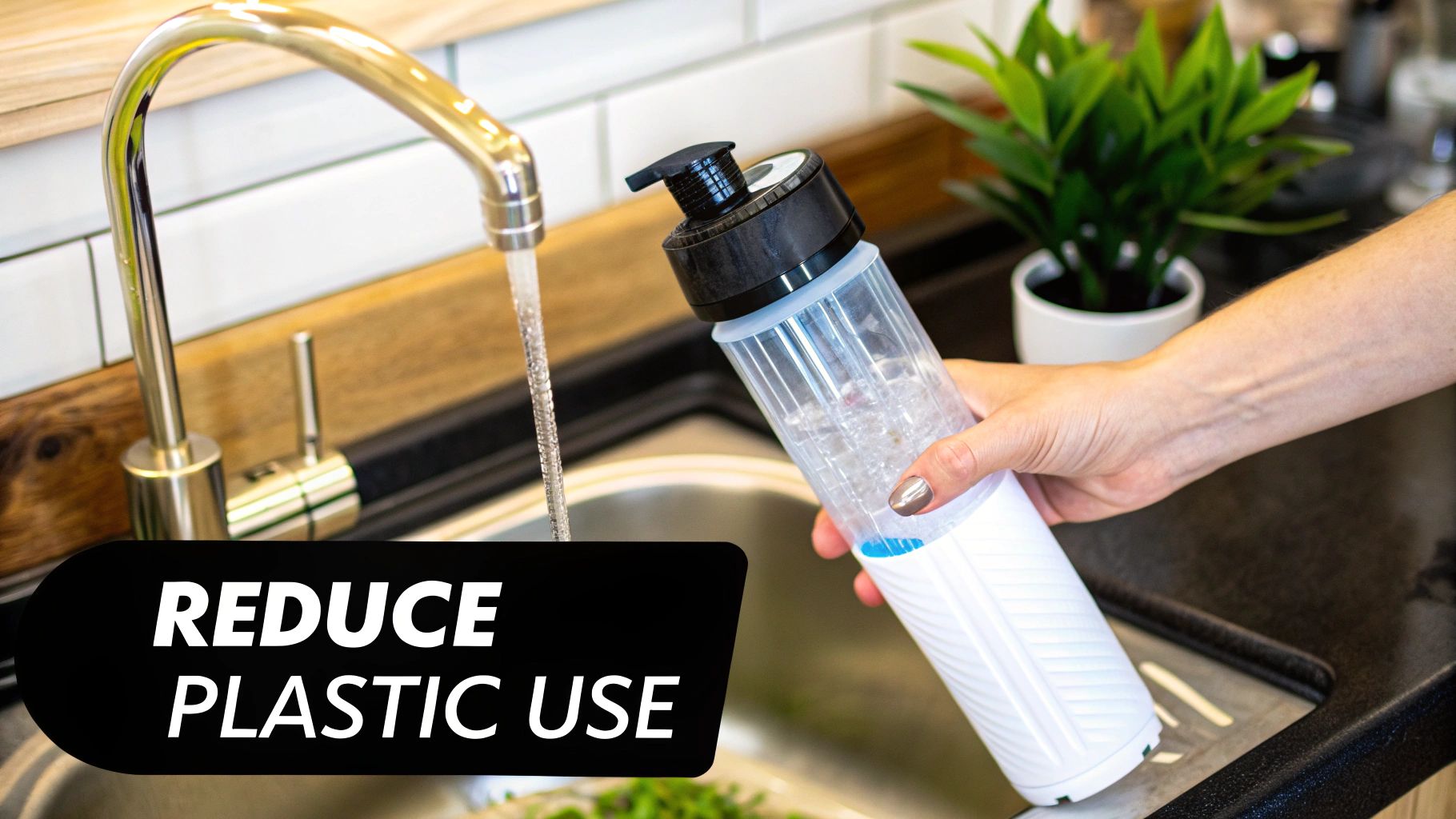
Microplastics Health Effects: What You Need to Know
Share
Plastics are so ingrained in modern life that we rarely think about their hidden side effect: the tiny, unseen particles they shed. These "microplastics" have become ubiquitous, turning up everywhere from the deepest oceans to the highest mountains—and, alarmingly, inside our own bodies.
This isn't just an environmental issue anymore. Growing research is connecting these microscopic invaders to very real health problems, like cellular damage, chronic inflammation, and potentially even serious diseases. The threat is no longer "out there"; it's inside us.
The Invisible Threat Inside Us

Think of microplastics as a kind of invisible dust. It doesn't just settle on your bookshelf; it weaves its way into our food, our water, and the very air we breathe. These fragments, often smaller than a grain of sand, break away from larger plastic items all around us—from the synthetic fibers in our clothes and the wear-and-tear of car tires to single-use water bottles and food packaging.
Their tiny size and sheer abundance mean they have a disturbingly easy time getting into our bodies. It happens in three main ways, often without us ever knowing.
Pathways into the Body
So, how do these particles make the jump from the environment into our systems? It happens through our most basic, everyday activities. Grasping these pathways is the first step toward understanding just how exposed we really are.
-
Ingestion: This is by far the most common route. We swallow microplastics that have contaminated our food and water. They're found in everything from seafood and salt to honey and beer. Even fruits and vegetables can absorb them from contaminated soil and water.
-
Inhalation: We also breathe them in. Microscopic plastic fibers shed from clothing, carpets, and upholstery become airborne. So do particles from tire dust on our roads. These fragments float in the air, entering our lungs with every breath we take.
-
Dermal Contact: Our skin is a pretty solid barrier, but it's not foolproof. The smallest of these particles, called nanoplastics, might get in through cuts or even hair follicles. Plus, certain chemicals used in plastics can be absorbed directly through the skin.
It's a sobering reality: scientists have now found microplastics in nearly every part of the human body they’ve looked. They're in our blood, lungs, liver, and have even been found to cross the placental barrier, reaching unborn babies. This steady buildup is what has health experts so concerned.
This isn't a hypothetical problem. The scale of our exposure is staggering. One study estimated that the average person could be taking in anywhere from 78,000 to 211,000 microplastic particles each year. This is why the World Economic Forum has flagged plastic pollution as a major global risk. You can get a deeper dive into how these plastics work their way up the food chain by checking out the latest findings on weforum.org.
To make it even clearer, here's a simple breakdown of how we're exposed.
How We Are Exposed to Microplastics
| Exposure Pathway | How It Happens | Common Sources |
|---|---|---|
| Ingestion | Eating or drinking products that contain plastic particles. | Bottled water, seafood, sea salt, beer, honey, plastic-packaged foods, produce grown in contaminated soil. |
| Inhalation | Breathing in airborne particles that have been shed from plastic-based products. | Synthetic textile fibers (clothing, carpets), city dust, tire wear particles, household dust. |
| Dermal Contact | Absorbing plastic-associated chemicals or nanoparticles through direct contact with the skin. | Cosmetics containing microbeads (now banned in many places), synthetic clothing, personal care products. |
This table shows just how many everyday items contribute to our "plastic load."
Why This Is a Personal Health Issue
The danger isn't just from having tiny, inert pieces of plastic lodged in our tissues. It gets worse. Many of these particles act like little toxic sponges, soaking up harmful chemicals from their surroundings, like pesticides and industrial pollutants.
Once these particles are inside us, they can leach these trapped toxins—including well-known endocrine disruptors like BPA and phthalates—directly into our system.
Suddenly, the abstract idea of "plastic pollution" becomes intensely personal. It’s no longer just about cluttered oceans; it's about foreign particles setting up shop in our vital organs. Facing the health effects of microplastics head-on is one of the most critical challenges for protecting our well-being today and for generations to come.
How Microplastics Journey Through the Body
It’s tempting to think that when we swallow or breathe in microplastics, they simply pass through our system and out the other side. Unfortunately, the reality is far more complex and troubling. These tiny plastic fragments are less like harmless debris and more like microscopic Trojan horses.
They don't just travel alone. During manufacturing, plastics are loaded with a cocktail of chemical additives to give them specific properties like flexibility or durability. Think of notorious chemicals like phthalates and Bisphenol A (BPA). The plastic particle itself becomes a delivery vehicle, carrying these harmful passengers deep into our bodies where they can be released.
This infographic breaks down how these particles can infiltrate major organ systems, showing just how widespread their internal contamination can become.

The key takeaway here is pretty clear: once microplastics get past our body's first line of defense, no organ is necessarily safe.
Absorption Into the Bloodstream
So, how do they make the jump from our gut or lungs into our blood? The process is called translocation, and it's the critical step that gives these particles an all-access pass to the rest of the body.
When you eat or drink something containing microplastics, the smallest of these particles can be absorbed right through your intestinal lining. Picture your gut wall as a very fine sieve. It’s designed to let nutrients pass through while blocking unwanted substances, but the tiniest plastic fragments—especially nanoplastics—are small enough to slip through the holes.
It's a similar story with inhalation. When we breathe in airborne fibers, they can travel deep into our lungs. The delicate tissues there, built for efficient oxygen exchange, can also inadvertently absorb these foreign particles directly into the bloodstream.
And this isn't just a theory. Researchers have already confirmed the presence of microplastics in human blood samples. This is a documented reality, proving that these particles are successfully bypassing our body's gatekeepers.
Once they're in the blood, they're swept along with everything else, like red blood cells and nutrients. This circulatory superhighway can carry them to destinations far from where they first entered.
Reaching Vital Organs
From the bloodstream, the journey gets even more concerning as microplastics reach our vital organs. The liver and kidneys, our body’s natural filtration plants, are often the first major stops. They work around the clock to clear out toxins, but they can't break down plastic. Instead, these organs can become sites where microplastics build up over time.
But the accumulation doesn't stop there. Evidence shows these particles can lodge themselves in other crucial areas:
- Heart and Arteries: Shockingly, particles have been found embedded within the arterial plaque that causes heart attacks and strokes.
- Spleen: As a vital part of the immune system that filters blood, the spleen can also trap these tiny invaders.
- Brain: Perhaps the most alarming finding is that the smallest nanoplastics may be able to cross the blood-brain barrier—a highly protective membrane that’s supposed to shield our brain from toxins.
The ability of microplastics to embed themselves in our tissues is what drives the well-documented microplastics health effects. Their physical presence alone can trigger chronic inflammation and cellular stress. Add in the toxic chemicals they leach, and you have a recipe for disrupting everything from hormonal balance to cellular function.
This journey—from a discarded water bottle to a cell deep inside our bodies—is the key to understanding the full scope of the health threat we're facing.
The Link Between Microplastics and Heart Disease

The idea of tiny bits of plastic circulating in our organs is unsettling enough. But now, groundbreaking science is making the consequences incredibly personal. We're moving past theory and into documenting the severe microplastics health effects on our cardiovascular system, connecting these particles to the medical events we fear most.
This connection all comes down to our body’s most basic defense mechanisms. Think about what happens when you get a splinter—the area gets red, swollen, and painful. That's inflammation, your immune system’s first line of defense against an invader. Microplastics appear to trigger a similar, yet far more sinister, reaction inside our blood vessels.
Inflammation: The Silent Instigator
When microscopic plastic particles manage to lodge themselves within the walls of our arteries, the body sees them for what they are: foreign objects that don't belong. It immediately flags them as a threat. Immune cells are dispatched to the site, trying their best to neutralize or get rid of the foreign material.
Here's the problem: the body can't break down plastic. So, the immune response never really turns off. It smolders away, becoming a state of chronic, low-grade inflammation. This constant irritation is a well-known driver of atherosclerosis—the slow, dangerous process where fatty plaques build up in arteries, making them narrow and stiff.
It’s like constantly scratching a mosquito bite. The initial irritation is minor, but the continuous agitation only makes it worse, causing more swelling, damage, and risk. In the same way, the chronic inflammation sparked by microplastics can destabilize the plaques already in our arteries, making them much more likely to rupture and cause a heart attack or stroke.
Oxidative Stress: A Cellular Attack
Working alongside inflammation is another damaging process called oxidative stress. This happens when our body gets flooded with unstable molecules called free radicals, creating a chemical imbalance. You can think of these free radicals as tiny, out-of-control wrecking balls, careening around and damaging cells, proteins, and even our DNA.
The presence of microplastic particles can dramatically ramp up the production of these free radicals in the surrounding tissue. This cellular-level stress adds yet another layer of damage, accelerating the hardening of the arteries and directly impairing the function of the delicate cells that line our blood vessels.
The one-two punch of chronic inflammation and oxidative stress creates a truly dangerous environment inside the cardiovascular system. It doesn't just add to the plaque buildup; it makes existing plaque more volatile and prone to causing a life-threatening blockage.
This isn't just a biological theory; it's now a measured clinical reality. The evidence tying microplastics to severe heart problems has become alarmingly clear, shifting the entire conversation from a potential risk to a documented danger.
The Shocking Clinical Evidence
For a long time, the link was mostly based on lab studies. That all changed with a landmark study that provided direct, undeniable human evidence. Researchers took a close look at plaque that was surgically removed from the carotid arteries of patients already suffering from heart disease. What they found was staggering.
The study revealed that patients whose arterial plaques contained microplastics had a 450% higher risk of suffering a heart attack, stroke, or death over the next three years, compared to patients whose plaques were free of plastic. To see the full scope of this research, you can learn more about the macro impacts of microplastics.
This isn't some minor statistical blip. The sheer magnitude of that risk—4.5 times higher—strongly suggests that the presence of microplastics in our arteries is a major, direct contributor to the progression of heart disease. The health effects of microplastics are no longer a distant, abstract problem. They are being actively measured in hospital operating rooms and in patient outcomes, proving that what we throw away can find its way back into our bodies with devastating consequences.
Broader Impacts on Chronic Disease and Public Health
The shocking link between microplastics and heart attacks is just one piece of a much larger puzzle. It's becoming clear that we're not just dealing with a specific risk factor for one condition. Instead, we're looking at a systemic problem, where these tiny particles may be contributing to a whole host of chronic diseases that impact millions of people.
This perspective shifts microplastics from a niche concern into a broad public health threat, one that could be silently fueling some of the most common illnesses we face today. Emerging research is starting to connect the dots between the sheer volume of microplastics in our environment and rising rates of noncommunicable diseases. It seems these particles, and the chemical cocktail they carry, are a problem that goes far beyond our arteries.
The Endocrine Disruption Connection
One of the most insidious ways microplastics can harm us is through endocrine disruption. Think of your endocrine system as your body's master control panel. It uses hormones—incredibly precise chemical messengers—to regulate everything from your metabolism and growth to your mood and ability to reproduce. It's a system built on delicate balance.
Here’s the problem: many of the chemicals added to plastics, like the infamous BPA and phthalates, are well-known endocrine-disrupting chemicals (EDCs). As microplastics break down inside our bodies, they can leach these chemicals. These EDCs are like chemical impostors; they can mimic our natural hormones, block their pathways, or send completely false signals, throwing the whole system into chaos.
This kind of interference can trigger a cascade of health issues:
- Metabolic Disorders: The endocrine system is in charge of how our bodies handle sugar and store fat. When it's disrupted, it's no surprise that we see links to a higher risk of obesity, metabolic syndrome, and Type 2 diabetes.
- Reproductive Problems: Hormonal balance is absolutely essential for fertility. EDCs have been tied to problems like lower sperm quality, irregular menstrual cycles, and even complications during pregnancy.
- Developmental Issues: This is especially concerning for fetuses and young children. Their developing bodies rely on precise hormonal cues to grow correctly. Exposure to EDCs in the womb or during early childhood could lead to developmental delays and other long-term disorders.
The real danger of endocrine disruption lies in its subtlety. It doesn't cause a sudden, obvious illness. It works slowly, undermining the body's fundamental control systems over years, contributing to chronic diseases that we might never trace back to their environmental source.
A New Public Health Risk Factor
Microplastic pollution is so widespread that it’s now being considered a major social determinant of health, right alongside things like air quality or access to clean water. And new research is making this connection impossible to ignore. For example, recent findings show that communities with higher levels of environmental microplastics also tend to have higher rates of hypertension, diabetes, and stroke. You can dive into the details of these public health findings to see the data for yourself.
This research paints a very unsettling picture. The health risk of living in a microplastic-polluted environment is now being compared to well-established risk factors, like being part of a minority group or not having health insurance. This means microplastic exposure isn't just a personal health concern—it's a serious driver of health disparities.
It's a matter of environmental justice. Communities situated near industrial zones, landfills, or areas with outdated water filtration systems are likely shouldering a much heavier burden of exposure. The health consequences of microplastics are probably hitting the most vulnerable among us the hardest.
This evidence forces us to reframe the entire problem. We're not just fighting individual particles causing isolated harm. We are facing a pervasive environmental contaminant that is adding to the global burden of chronic disease. It’s a silent, constant stressor on our collective health—one that requires immediate action from all of us to protect our future.
Practical Ways to Reduce Your Microplastic Exposure
Learning about the pervasive nature of microplastics can feel unsettling, to say the least. It’s one thing to know they exist, but another to feel like you have any control over them. The good news? You do.
You don’t have to aim for a perfectly plastic-free life, which is nearly impossible anyway. Instead, think about making smart, targeted changes where they count the most. By focusing on the biggest hotspots for exposure—your kitchen, your drinking water, and even the air you breathe—you can significantly cut down your daily dose of these tiny particles.
Start in Your Kitchen
The kitchen is ground zero for a lot of our microplastic intake, mostly from how we store and cook our food. A few simple swaps here can make a world of difference.
-
Ditch Plastic Food Containers: This is the big one. Never, ever heat your food in plastic. When you microwave a plastic container, the heat causes it to degrade and shed an enormous amount of particles directly into your meal. Switch to glass, stainless steel, or ceramic containers for storing and especially for reheating.
-
Rethink Your Utensils: That plastic spatula you use to scramble eggs? Or the spoon for stirring hot soup? They can shed tiny plastic fragments right into your food as they heat up. It’s a much safer bet to use tools made from wood, bamboo, or stainless steel.
-
Swap Out Plastic Wrap and Cutting Boards: Every time you slice something on a plastic cutting board, your knife creates microscopic shavings that mix in with your food. And that plastic wrap touching your sandwich isn't as harmless as it looks. Try using beeswax wraps or reusable silicone lids, and make the switch to a classic wood or bamboo cutting board.
A study on microwaving plastic containers was truly eye-opening. Researchers found that heating food in certain types of plastic could release millions of microplastics and billions of even tinier nanoplastics from just a single square centimeter of the container. Heat is truly plastic's worst enemy in the kitchen.
Making these small adjustments creates a much safer environment for your food and is one of the most direct ways to reduce ingestion.
Purify Your Water and Air
Beyond what you eat, the water you drink and the air in your home are two other major pathways for exposure. Thankfully, filtration can be incredibly effective at capturing these particles before they get inside your body.
Filter Your Water You might think bottled water is purer, but it's often the opposite. Studies have found that bottled water can contain hundreds of times more microplastic particles than tap water, largely because of particles shedding from the plastic bottle and cap. Your best bet is filtering your own tap water.
- Look for a high-quality water filter certified for microplastic removal. Reverse osmosis (RO) systems are the gold standard here, but many carbon block filters are also highly effective.
- Even a basic pitcher filter is better than nothing. Just check the product's specs to see if it’s designed to capture very small particulate matter.
Clean Your Air We don’t often think about breathing in plastic, but microfibers are constantly shedding from our clothes, carpets, and furniture. These fibers become airborne and can travel deep into our lungs.
- Invest in a good air purifier equipped with a HEPA (High-Efficiency Particulate Air) filter. HEPA filters are specifically designed to trap microscopic particles, including these plastic fibers.
- Vacuum your home regularly, preferably with a vacuum that also has a HEPA filter. This traps particles that have settled on surfaces before they can be kicked back up into the air.
Make Conscious Consumer Choices
Every dollar you spend sends a message. By consciously choosing products that minimize plastic, you not only lower your own exposure but also help drive market demand for safer, more sustainable alternatives.
Thinking about where you can make the biggest impact can feel overwhelming, so I've put together a simple action plan to get you started.
Your Action Plan to Minimize Microplastic Exposure
This table is a simple checklist of practical, high-impact changes you can make in different areas of your life to reduce your daily contact with microplastics.
| Area of Life | High-Impact Action | Why It Works |
|---|---|---|
| Clothing | Choose natural fibers like cotton, wool, and linen over synthetics like polyester, nylon, and acrylic. | Synthetic fabrics are a leading source of microplastic pollution. They release thousands of tiny fibers into the air and our waterways with every wash. |
| Personal Care | Read ingredient lists to avoid products with microbeads or glitter. Look for "polyethylene" or "polypropylene." | These tiny plastic particles are designed to be washed down the drain, adding directly to water pollution and eventually entering the food chain. |
| Groceries | Opt for loose produce and buy food sold in glass jars or metal cans. Support brands like the Naked Pantry that focus on plastic-free options. | Reducing plastic packaging is a direct way to prevent plastic particles from shedding onto your food. Supporting zero-waste companies helps shift the entire industry. |
While completely eliminating microplastics from our lives isn't realistic right now, taking these practical steps puts you back in the driver's seat. Each change, no matter how small it seems, contributes to a healthier environment for you and your family.
Of course. Here is the rewritten section, designed to sound completely human-written and natural.
Your Top Questions About Microplastics and Health, Answered
As the conversation around microplastics gets louder, so do the questions. The science can feel overwhelming, and it's completely normal to worry about what this all means for you and your family. Let's cut through the noise and tackle some of the most common concerns with clear, straightforward answers.
Can My Body Actually Get Rid of These Things?
This is the big one, isn't it? The answer is a classic "yes and no." Our bodies are incredibly good at protecting us, and they do have ways of kicking out foreign invaders. When we swallow larger microplastic fragments, they often just pass right through our digestive system and get flushed out.
The real trouble starts with the tiniest particles, especially nanoplastics. These are so small they can sneak right through the lining of our gut and slip into the bloodstream.
Once they're in circulation, they can travel anywhere, eventually getting stuck in our tissues and organs. While our liver and kidneys work tirelessly to filter out junk, they were never designed to handle bits of synthetic plastic. The constant, daily stream of these particles can simply overwhelm our natural defenses, causing them to build up over time.
A good way to think about it is like a kitchen sink with a slow drain. A little bit of water gets through just fine, but turn the faucet on full blast and it’s going to back up and overflow. Our bodies can manage a few particles, but the continuous exposure we all face is what leads to that dangerous accumulation.
Are Some Plastics Worse Than Others?
Yes, absolutely. While any tiny foreign object can cause physical irritation and inflammation just by being there, the type of plastic makes a huge difference. Some are just plain more toxic than others.
For instance, plastics like polyvinyl chloride (PVC) or polycarbonate (think older, hard-plastic reusable bottles) are notorious for containing a cocktail of nasty chemical additives. We're talking about things like phthalates, heavy metals, and bisphenol A (BPA).
These chemicals aren't permanently glued to the plastic. When a microplastic particle is floating around in the warm, wet environment inside our bodies, these toxins can leach out and get absorbed directly by our tissues. This turns the particle from a simple physical problem into a miniature toxic delivery system.
Here’s a quick rundown of a few common plastics you'll encounter:
| Plastic Type | Where You'll Find It | The Main Concern |
|---|---|---|
| PVC | Pipes, vinyl flooring, some packaging | Can release phthalates and heavy metals, which are known endocrine disruptors and toxins. |
| Polycarbonate | Old reusable water bottles, food containers | A primary source of BPA, a well-known chemical that messes with our hormones. |
| PET | Single-use water bottles, soda bottles | Generally considered safer, but can leach chemicals like antimony, especially when heated or left in the sun. |
| Polystyrene | Foam coffee cups, takeout clamshells | Can shed styrene, a chemical that's been flagged as a possible carcinogen. |
This is why understanding the health effects of microplastics requires looking at both the physical particle and the chemical baggage it carries.
Can I Get Tested to See How Many Microplastics Are in My Body?
As of right now, there’s no simple test you can order to find out your personal "microplastic count." The methods scientists use to find these particles are incredibly specialized and exist only in high-tech research labs.
Researchers use powerful tools like Raman spectroscopy and pyrolysis-gas chromatography-mass spectrometry to painstakingly identify and count plastic fragments in human blood, organ tissue, and even stool samples. It's a complex and expensive process that just isn't ready for clinical or public use.
For now, the best mindset is to assume we all have some level of exposure. The goal isn't to get a score, but to be proactive. Focus on prevention by making the smart lifestyle choices that minimize how many more particles you take in. As the research gets better, we may see accessible tests become available down the road.
Does Washing or Cooking Food Get Rid of Microplastics?
This is another question where the answer is, "it helps, but only a little." Giving your fruits and vegetables a good wash and scrub can definitely remove some of the microplastic dust that’s settled on the outside.
But for many of the foods we eat, washing and cooking don't solve the problem.
- They’re already inside: In foods like fish, shrimp, or even sea salt, the microplastics are already part of the product. They’re in the muscle tissue of the fish or mixed in with the salt crystals. No amount of rinsing is going to get those out.
- Heat makes it worse: Cooking with plastic is one of the biggest mistakes you can make. High heat breaks down plastic packaging, containers, and non-stick coatings, causing them to shed millions of particles directly into your meal.
Your safest bet is to always cook with materials like glass, ceramic, or stainless steel. So yes, keep washing your produce—it’s a great habit. But the most powerful change you can make in the kitchen is to create a buffer between your food and plastic, especially when things get hot.
Ready to clear your pantry of plastic and reduce your family's exposure? Naked Pantry makes it simple. We deliver high-quality, organic pantry staples—from grains and pasta to snacks and coffee—in 100% plastic-free, compostable packaging. Take control of what's in your food and on your shelves by exploring our plastic-free collections.
